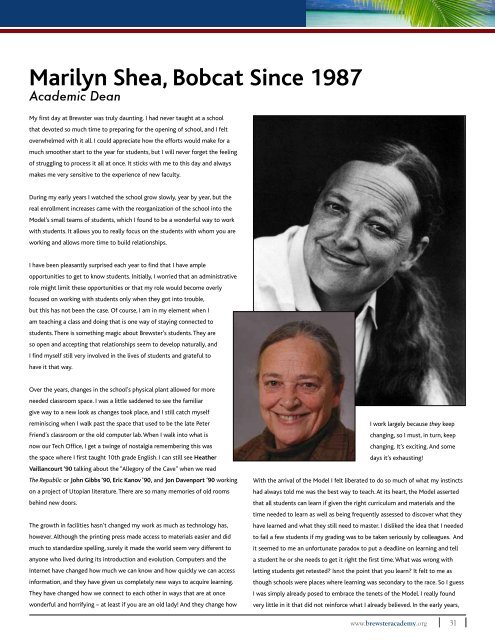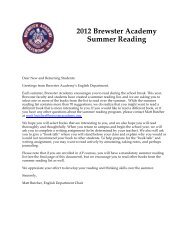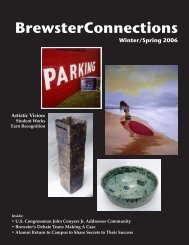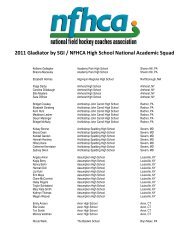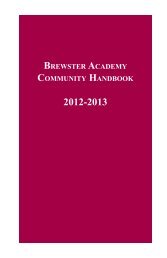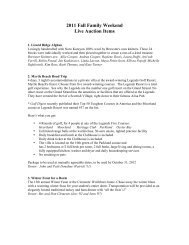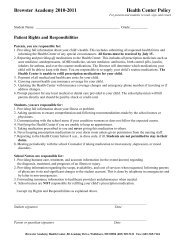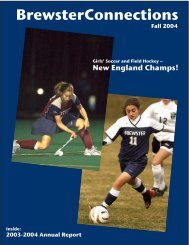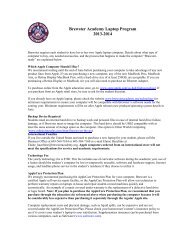BrewsterConnections(PDF) - Brewster Academy
BrewsterConnections(PDF) - Brewster Academy
BrewsterConnections(PDF) - Brewster Academy
Create successful ePaper yourself
Turn your PDF publications into a flip-book with our unique Google optimized e-Paper software.
Marilyn Shea, Bobcat Since 1987<br />
Academic Dean<br />
My first day at <strong>Brewster</strong> was truly daunting. I had never taught at a school<br />
that devoted so much time to preparing for the opening of school, and I felt<br />
overwhelmed with it all. I could appreciate how the efforts would make for a<br />
much smoother start to the year for students, but I will never forget the feeling<br />
of struggling to process it all at once. It sticks with me to this day and always<br />
makes me very sensitive to the experience of new faculty.<br />
During my early years I watched the school grow slowly, year by year, but the<br />
real enrollment increases came with the reorganization of the school into the<br />
Model’s small teams of students, which I found to be a wonderful way to work<br />
with students. It allows you to really focus on the students with whom you are<br />
working and allows more time to build relationships.<br />
I have been pleasantly surprised each year to find that I have ample<br />
opportunities to get to know students. Initially, I worried that an administrative<br />
role might limit these opportunities or that my role would become overly<br />
focused on working with students only when they got into trouble,<br />
but this has not been the case. Of course, I am in my element when I<br />
am teaching a class and doing that is one way of staying connected to<br />
students. There is something magic about <strong>Brewster</strong>’s students. They are<br />
so open and accepting that relationships seem to develop naturally, and<br />
I find myself still very involved in the lives of students and grateful to<br />
have it that way.<br />
Over the years, changes in the school’s physical plant allowed for more<br />
needed classroom space. I was a little saddened to see the familiar<br />
give way to a new look as changes took place, and I still catch myself<br />
reminiscing when I walk past the space that used to be the late Peter<br />
Friend’s classroom or the old computer lab. When I walk into what is<br />
now our Tech Office, I get a twinge of nostalgia remembering this was<br />
the space where I first taught 10th grade English. I can still see Heather<br />
Vaillancourt ‘90 talking about the “Allegory of the Cave” when we read<br />
The Republic or John Gibbs ‘90, Eric Kanov ‘90, and Jon Davenport ’90 working<br />
on a project of Utopian literature. There are so many memories of old rooms<br />
behind new doors.<br />
The growth in facilities hasn’t changed my work as much as technology has,<br />
however. Although the printing press made access to materials easier and did<br />
much to standardize spelling, surely it made the world seem very different to<br />
anyone who lived during its introduction and evolution. Computers and the<br />
Internet have changed how much we can know and how quickly we can access<br />
information, and they have given us completely new ways to acquire learning.<br />
They have changed how we connect to each other in ways that are at once<br />
wonderful and horrifying – at least if you are an old lady! And they change how<br />
I work largely because they keep<br />
changing, so I must, in turn, keep<br />
changing. It’s exciting. And some<br />
days it’s exhausting!<br />
With the arrival of the Model I felt liberated to do so much of what my instincts<br />
had always told me was the best way to teach. At its heart, the Model asserted<br />
that all students can learn if given the right curriculum and materials and the<br />
time needed to learn as well as being frequently assessed to discover what they<br />
have learned and what they still need to master. I disliked the idea that I needed<br />
to fail a few students if my grading was to be taken seriously by colleagues. And<br />
it seemed to me an unfortunate paradox to put a deadline on learning and tell<br />
a student he or she needs to get it right the first time. What was wrong with<br />
letting students get retested? Isn›t the point that you learn? It felt to me as<br />
though schools were places where learning was secondary to the race. So I guess<br />
I was simply already posed to embrace the tenets of the Model. I really found<br />
very little in it that did not reinforce what I already believed. In the early years,<br />
www.brewsteracademy.org<br />
31


